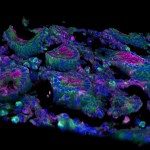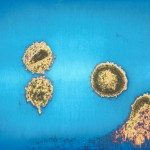Link to Pubmed [PMID] – 33952636
Link to DOI – 10.1128/JVI.00016-21
J Virol 2021 06; 95(14): e0001621
HIV-1 Gag p24 has long been identified as an informative biomarker of HIV replication, disease progression, and therapeutic efficacy, but the lower sensitivity of immunoassays in comparison to molecular tests and the interference with antibodies in chronic HIV infection limit its application for clinical monitoring. The development of ultrasensitive protein detection technologies may help in overcoming these limitations. Here, we evaluated whether immune complex dissociation combined with ultrasensitive digital enzyme-linked immunosorbent assay (ELISA) single-molecule array (Simoa) technology could be used to quantify p24 in plasma samples from people with HIV-1 infection. We found that, among different immune complex dissociation methods, only acid-mediated dissociation was compatible with ultrasensitive p24 quantification by digital ELISA, strongly enhancing p24 detection at different stages of HIV-1 infection. We show that ultrasensitive p24 levels correlated positively with plasma HIV RNA and HIV DNA and negatively with CD4-positive (CD4+) T cells in the samples from people with primary and chronic HIV-1 infection. In addition, p24 levels also correlated with plasma D-dimers and interferon alpha (IFN-α) levels. p24 levels sharply decreased to undetectable levels after initiation of combined antiretroviral treatment (cART). However, we identified a group of people who, 48 weeks after cART initiation, had detectable p24 levels despite most having undetectable viral loads. These people had different virological and immunological baseline characteristics compared with people who had undetectable p24 after cART. These results demonstrate that ultrasensitive p24 analysis provides an efficient and robust means to monitor p24 antigen in plasma samples from people with HIV-1 infection, including during antiretroviral treatment, and may provide complementary information to other commonly used biomarkers. IMPORTANCE The introduction of combined antiretroviral treatment has transformed HIV-1 infection into a manageable condition. In this context, there is a need for additional biomarkers to monitor HIV-1 residual disease or the outcome of new interventions, such as in the case of HIV cure strategies. The p24 antigen has a long half-life outside viral particles, and it is, therefore, a very promising marker to monitor episodes of viral replication or transient activation of the viral reservoir. However, the formation of immune complexes with anti-p24 antibodies makes its quantification difficult beyond acute HIV-1 infection. We show here that, upon immune complex dissociation, new technologies allow the ultrasensitive p24 quantification in plasma samples throughout HIV-1 infection at levels close to those of viral RNA and DNA determinations. Our results further indicate that ultrasensitive p24 quantification may have added value when used in combination with other classic clinical biomarkers.








